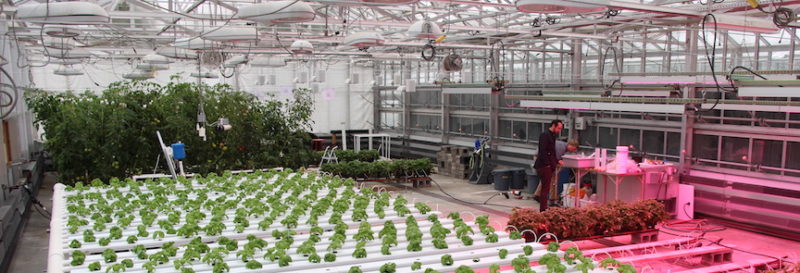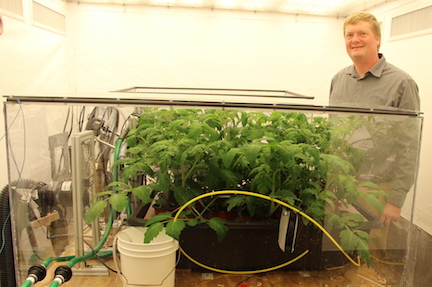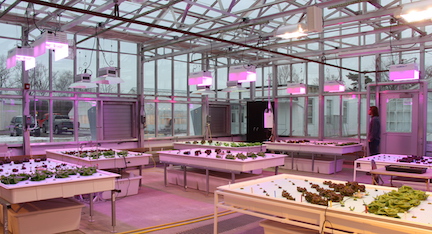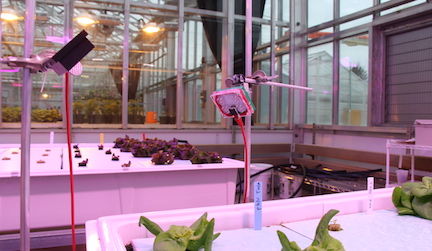
Technology — Enlightening the Industry on Greenhouse Technology
Controlled environment agriculture (CEA) growers are constantly looking for new technologies to optimize production efficiency and increase operation profitability.
The development of affordable sensors and advanced environmental control systems allows growers to monitor and control the crop production environment like never before. In 2020, gathering information will not be a problem; instead, how to use the data will be a challenge.
This uncertainty and the lack of published information have slowed down the implementation of energy efficient technologies in commercial CEA facilities. In the competitive CEA industry, the majority of the growers will wait for a new technology to become widely adopted before trying it in their own facilities. Take as an example the use of LED lights. Despite the increased energy efficiency of LED lighting systems compared to conventional high pressure sodium (HPS) lights, the LED implementation rate is still low — according to the Department of Energy, just 2% of the U.S. lit commercial greenhouses have adopted LED technologies.
To support new technology adoption, the Greenhouse Lighting and Systems Engineering (GLASE) consortium was created. GLASE brings together different areas of expertise from academia and the marketplace to create a hub for technology and information exchange among the industry stakeholders. Researchers, growers and CEA technology manufacturers are working together to lead the way into the future and accelerate the implementation of new energy efficient technologies.
WHAT IS GLASE?
GLASE is a public-private consortium created to develop, transfer and implement new energy efficient technologies aimed to improve production efficiency of CEA systems. Formed by Cornell University, Rensselaer Polytechnic Institute (RPI) and Rutgers University, GLASE is pursuing breakthrough research activities to improve lighting fixtures and systems to synergistically control lighting, ventilation, humidity and CO2, all of which will improve CEA operations, reduce energy consumption and create a more sustainable and profitable greenhouse industry.

Established in 2017, GLASE received $5 million from the New York State Energy Research and Development Authority (NYSERDA) to fund a seven-year program with more than 350 technical milestones. Today, GLASE has 24 industry members, of which half are CEA growers. The participation of industry members is an important aspect of the consortium framework. Through the participation of the board in the industry advisory board meetings, CEA growers and technology manufacturers provide GLASE researchers with technical feedback and guidance to ensure the development of solutions to relevant industry needs.
DEVELOPING ENERGY EFFICIENT LIGHTING SYSTEMS

In commercial controlled environment production, the key to acquire and retain long-term customers involves one simple concept: producing a consistent, high-quality crop at a predictable and steady rate, 365 days per year. Accurately measuring and controlling lighting conditions allows growers to achieve a stable growing environment under variable weather on a daily basis across the four seasons of the year. But lighting is not a simple factor to be controlled.
There are several direct and indirect aspects related to lighting management, which can affect crop production and systems energy use efficiency. Following are some of the new technologies being developed at GLASE to improve lighting management and climate control in CEA systems.
Supplemental Lighting System Control — More than any other environmental variable, the total sum of light received by the plants in a 24-hour period determines the rate that the plants grow and thus the amount of product available for sale. The total amount of incident light is measured as the daily light integral (DLI), the number of photosynthetically active photons reaching the plant per day. Due to weather variability, growers often experience decreased crop production in the winter due to low natural lighting conditions, whereas produce damage can be experienced during the summer due to excess light.

To achieve consistent lighting conditions, a control algorithm was created that can predict the total solar (natural) DLI. Based on this information, supplemental lights and movable shades can be adjusted via the algorithm to achieve the optimal DLI every day. This control algorithm was developed at Cornell University and is called LASSI, for Light and Shade System Implementation.
In addition to providing consistent, predictable year-round production, LASSI also has been proven to reduce the energy use of a greenhouse when compared to other supplemental light control strategies such as threshold control (turning the lights on/off when natural light is below/above set targets). LASSI was implemented in two commercial greenhouses in New York serving as GLASE pilots. A baseline will be established and the energy efficiency improvements provided by LASSI will be demonstrated.
Spectrum Control — The question of how the solar spectrum changes over time is important for providing the best light environment for crop production. Light is the energy source in photosynthesis and light also serves as an important cue for developmental responses.
GLASE researchers at the Center for Lighting Enabled Systems and Applications (LESA) at RPI have built a Spectral Acquisition Sensor System (SASSy) that can measure variations in the composition of the solar spectrum over the course of the day. Once we understand how the spectrum of sunlight changes over time, GLASE researchers will use tunable LED fixtures developed at LESA to study the benefits of supplemental lighting spectrum control. The SASSy unit is currently recording data in a greenhouse at Cornell University. It is one of the first robust spectrometer systems created for recording solar spectrum in a greenhouse over long time periods.
CO2 and Lighting control — In high density production CEA operations, CO2 supplementation is often used to increase biomass production. GLASE researchers at Cornell University are studying lettuce, tomato and strawberry biomass responses to light levels and CO2 concentration. The findings from the CO2 trials will be integrated into the existing LASSI control software to simultaneously control CO2 enrichment and supplemental lighting. The new “CO2 LASSI” will allow growers to optimize crop production management to help reduce supplemental lighting requirements.
Integrated Controls — Lighting is often controlled in conjunction with other environmental factors using climate control systems. Replacing a lighting system (e.g., replacing HPS bulbs with LED fixtures) or modifying the lighting control strategy (e.g., DLI control vs. threshold or timer control) will affect other production factors. For example, a semi-closed greenhouse uses a small mechanical cooling system at certain times of the year to remove latent heat, thereby reducing ventilation and waste of supplemental CO2.
To determine the impacts of new energy efficient technologies, GLASE researchers are improving existing energy modeling software to accommodate the use of integrated climate management strategies. The new software will allow CEA growers to simulate complicated heating, ventilation, and air conditioning (HVAC) systems that can account for the impacts of heat load differences between LED and HPS lighting systems and the use of integrated CO2 enrichment systems.
MEMBER PARTICIPATION
To help facilitate technology implementation, GLASE has developed an outreach program to support technology manufacturers and CEA growers by providing scientific based information and industry insights with the goal of getting new technologies quickly to the market.
The outreach program is designed to bridge the gap between academia and industry, in this way keeping growers and manufacturers informed about the latest technologies through a series of webinars featuring new scientific and technological innovations and best practices in the CEA industry. In addition to the opportunity to work with other GLASE members to develop new opportunities for all, GLASE members participate in the consortium Industrial Advisory Board meetings, which are held on a quarterly basis.
To find out more about the consortium activities and how to get involved please visit glase.org.









 Video Library
Video Library 


















